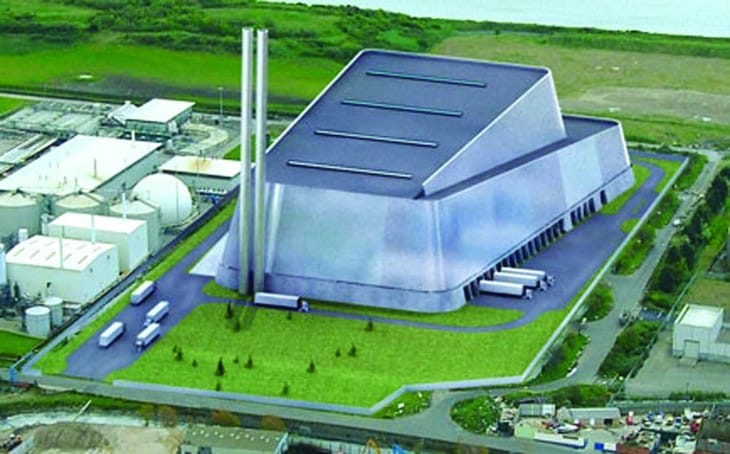By John Gormley
The i-word wasn’t mentioned once in the official announcement about the Unesco designation of Dublin bay. In fact, the City Council officials managed to studiously avoid any reference to the incinerator. The omission is understandable, I suppose, because the incinerator on the Poolbeg peninsula is not compatible with the lofty desire to protect the natural heritage of the bay. It’s a blot on the landscape even as it’s being constructed, and when it’s complete it will be bigger and higher than Croke Park. For the next quarter of a century – the usual lifetime of a municipal incinerator – it will stand as a monument to stupidity, bureaucratic intransigence and the lack of local democracy.
The authorities have now conceded that this is a national incinerator, as it will have to take waste from all over the country to feed the 600,000 tonne monster. This was a central point of the opponents of the incinerator, led by CRAI (Combined Residents Against Incineration). As Minister for the Environment, I made my opposition to mass burn incineration very clear. I succeeded in stopping the incinerator through the introduction of incineration levies. Covanta, the US multinational behind the project, stated at the time that they would not operate plant if incineration levies were in place. They lobbied my successor, Phil Hogan, while he was in opposition and he obliged them by abandoning the levy scheme when he became Minister. When I got wind of the meeting between Covanta and Big Phil, I mentioned it in a press release. Phil sent me a solicitor’s letter which I promptly dropped into the recycling bin. By this stage, he had also initiated proceedings against me with SIPOC, alleging that I had abused my position as Minister by delaying the issuing of a foreshore licence for the plant. SIPOC found, having spent a year and half, going through the relevant files, that I had no case to answer. In fact, the plant did not require a foreshore licence and it was no coincidence that Dublin City council withdrew their licence application the day after I resigned as Minister.
None of this got much coverage in the mainstream media, unlike the blanket coverage given to the granting of planning permission and the EPA licence both of which had nothing to do with me. It’s no wonder then that people were confused, some of them thinking that I had given the plant planning permission, while others believed I was behaving in an illegal and underhand way to stop the incinerator.
Few journalists have explained clearly the background to this project, the exceptions being Victoria White in the Examiner, Nick Webb and Shane Ross in their book ‘The Untouchables’, and of course James Nix in Village magazine. RTE’s ‘Primetime’ too deserves credit for exposing the significant investment from the National Pensions Reserve Fund and AIB. This means that the incinerator is in fact a government sponsored project.
In a normal democracy if a project of this size had serious and inexplicable cost overruns there would be an independent inquiry. Not so here. The more cynical of you might wonder if there’s any point to such an inquiry, given that inquiries and tribunals in the past never resulted in consequences for those found culpable of wrongdoing or incompetence. A fair point, perhaps. But it’s always good to get the truth and to learn from the mistakes made.
An inquiry would reveal how the Dublin City Council ignored the Minister’s request not to sign the contract with Covanta, then refused to give the Minister a copy of the contract until the Attorney General intervened; it would prove, as stated clearly in the Hennessy Report, that DCC could not have been sued for breach of contact. Most importantly, from an environmental point of view, an inquiry would show that Ireland could comfortably meet its recycling targets without this giant incinerator. The evidence from Scandinavia is that large volumes of recyclables are being diverted to municipal incinerators, which of course increases our Greenhouse gas emissions. By the way, the argument that incinerators reduce Greenhouse gas emissions is only true if organic matter such, as waste food is dumped, in landfills. We ought of course to be banning food waste from landfills.
At the very time when waste-management technology is about to be revolutionised, Ireland will once again be behind the curve. Incinerators will be considered antiquated technology in twenty five years time. Unfortunately, when that time comes we’ll still have one of the biggest incinerators in Europe – plonked bang in the middle of a UNESCO heritage site. And it’s that sense of lost opportunity that is the most depressing aspect of this debacle.
The Poolbeg Peninsula with its Nature Park, South Wall, classical Pidgeon House, iconic barber pole chimneys and much more should be the jewel in the crown of Dublin Bay and the gateway to the city itself. Now our visionless bureaucrats have consigned it to the slag heap for the next quarter of a century. •
